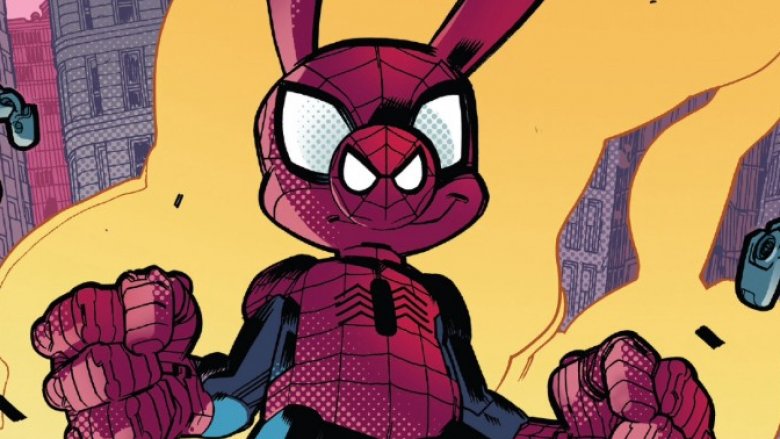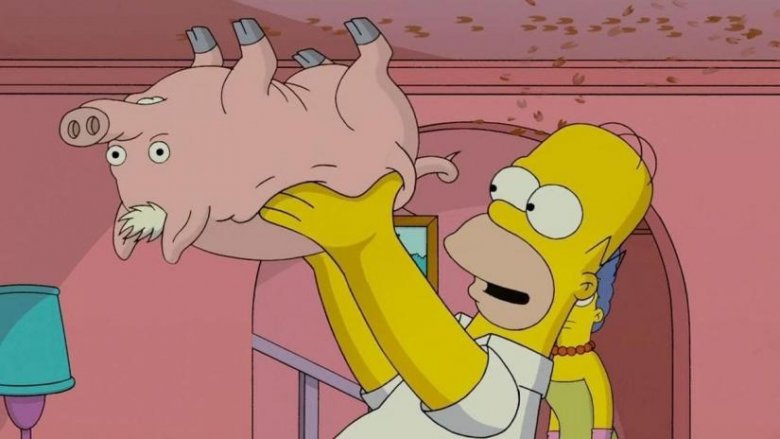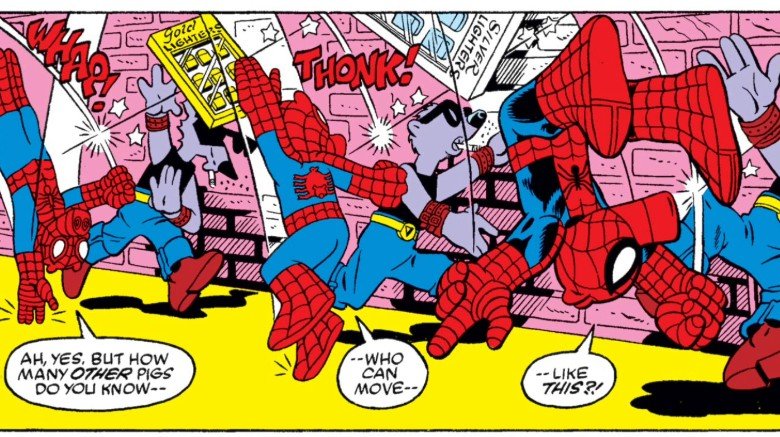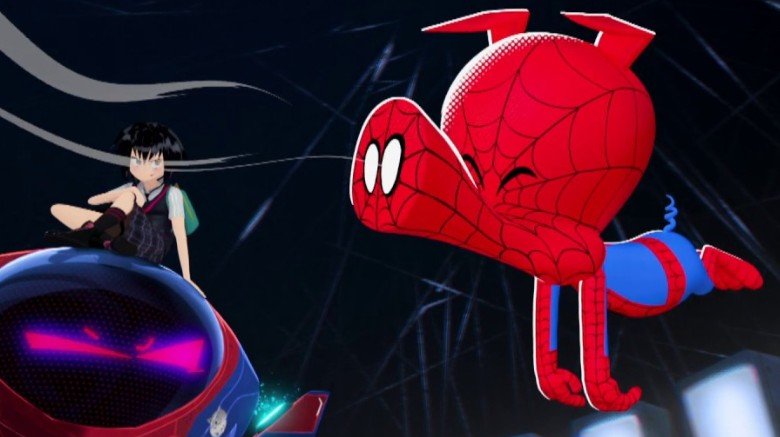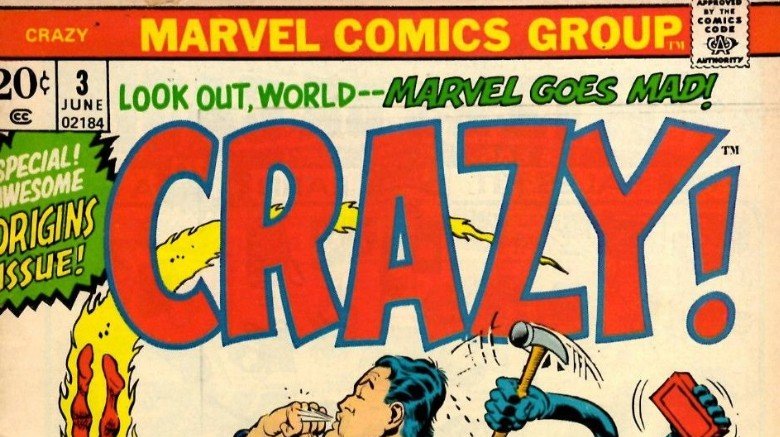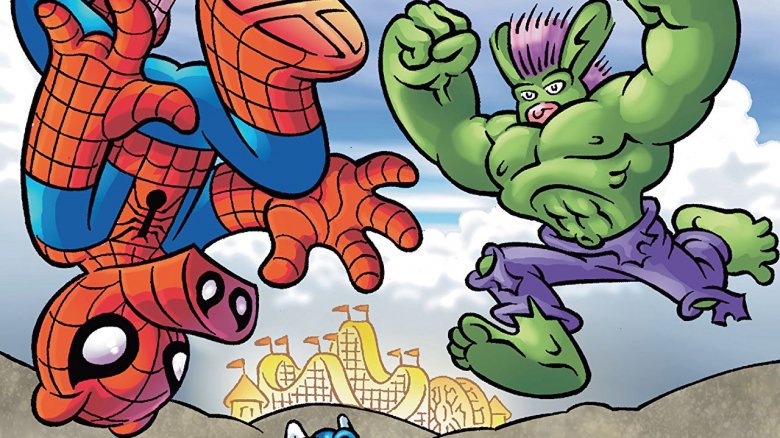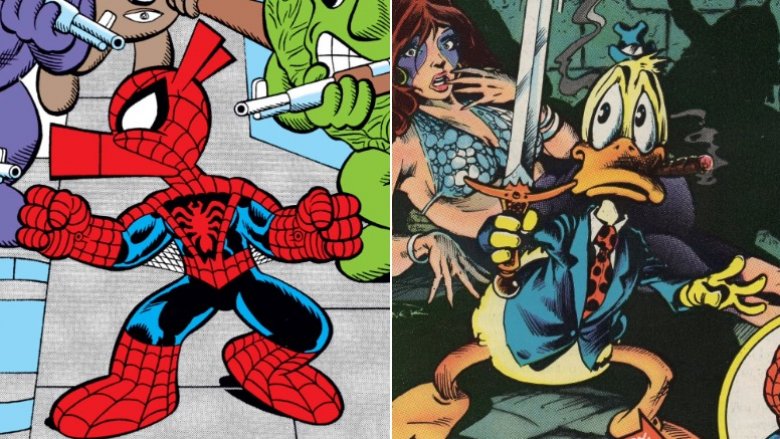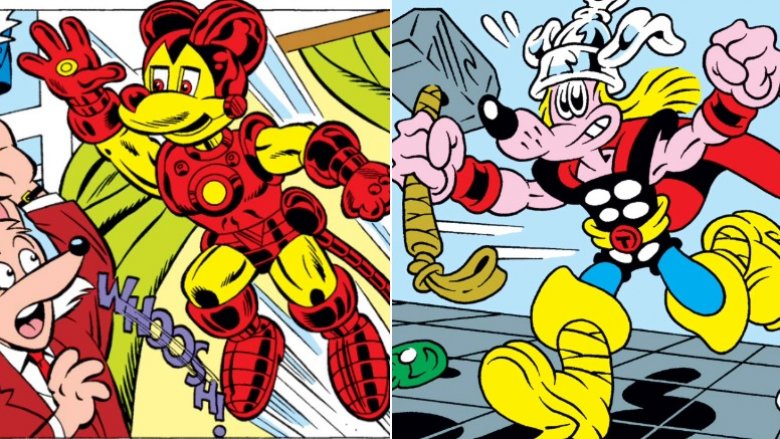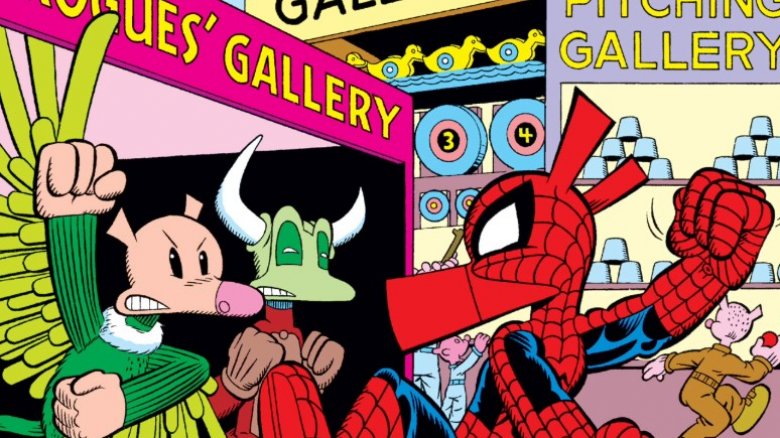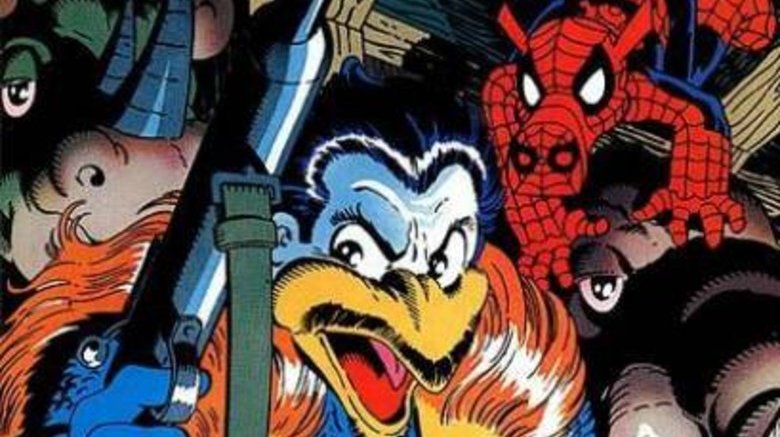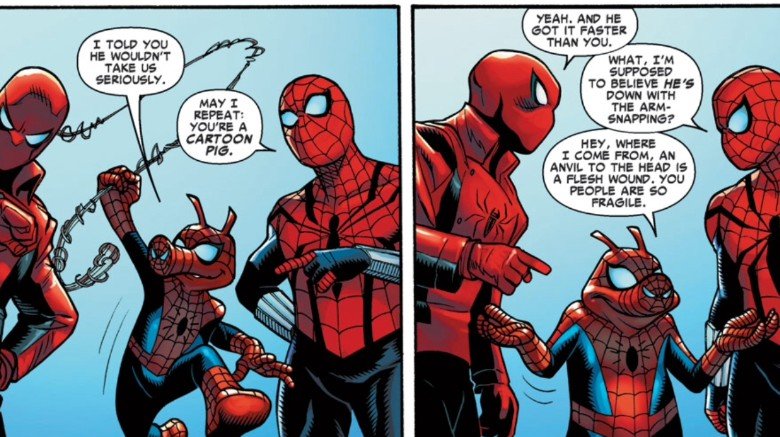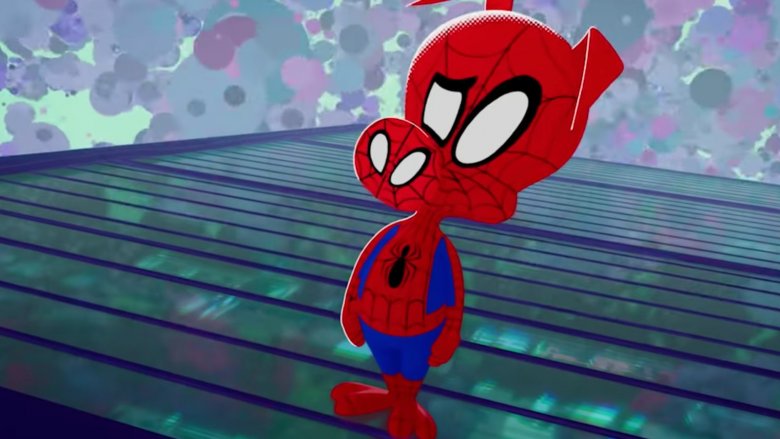The Untold Truth Of Spider-Ham
Peter Porker, the Spectacular Spider-Ham, is a hero that Marvel Comics fans have known about for a while. But the heroic pig earned a boost in visibility with the 2018 hit Spider-Man: Into the Spider-Verse. The animated film includes multiple versions of Spider-Man from alternate realities, including the super swine himself.
In 1987's Peter Porker, the Spectacular Spider-Ham #15, we learn that Peter Porker isn't a pig who was bitten by a spider. Bizarrely, it's the other way around. In a flashback, Peter is a spider hanging out in May Porker's basement while she conducts an experiment meant to introduce nuclear fission into the beauty salons of America. When May zaps herself with her invention, she temporarily goes wild, grabs Peter off the wall, and bites him. As a result, Peter the spider becomes Peter the pig, but he retains the proportional strength and agility of a spider, along with other abilities like wall-crawling.
Spider-Ham has sadly remained on the periphery of Marvel Comics for decades, but since the success of Into the Spider-Verse, the little sausage hero is making himself more and more visible in popular media. So, we think maybe it might be time for the untold truth of Spider-Ham.
Which came first, the Ham or the Pig?
Many people who haven't been shameless comic fans since childhood first learned of the existence of Spider-Ham in the excellent 2018 animated film Spider-Man: Into the Spider-Verse. Because of this, some audience members — particularly Simpsons fans — may find themselves asking "Which came first, the ham or the pig?" (Well, metaphorically, of course. In real life, the ham/pig order is fairly obvious and, depending on who you are, possibly tragic.)
One of the more well-remembered scenes of 2007's The Simpsons Movie features the clueless Homer Simpson doing something characteristically stupid and hilarious — holding the family's pet pig Plopper upside down and forcing it to walk on the ceiling. Meanwhile, Homer sings to the tune of the old '60s Spider-Man cartoon, "Spider-Pig, Spider-Pig, does whatever a Spider-Pig Does. Can he swing from a web? No, he can't. He's a pig."
It would be understandable if, in light of this, you wondered if Marvel swiped the idea for Spider-Ham from The Simpsons Movie. But alas, it isn't so. Peter Porker, the Spectacular Spider-Ham, pre-dates Homer Simpson's Spider-Pig serenade by over 20 years, as he first appeared in 1983's Marvel Tails #1. So in this is case — as opposed to just about every other example you can think of — the Ham came before the Pig.
The first Spider-Ham comic was an unexpected hit
According to a 2010 issue of the magazine Back Issue, the creation of Spider-Ham came out of a discussion between Marvel Comics pros Tom DeFalco and Larry Hama about the possibilities of licensing toys and animated TV projects. Hama was particularly interested in plush toys, and DeFalco said that led Hama to the idea of a "funny-animal talking" title, while it was DeFalco who conceived specifically of Spider-Ham.
Riffing off the Marvel Tales comic that reprinted old stories, DeFalco and Hama got the 1983 one-shot Marvel Tails #1 greenlit. DeFalco wrote the story, with Mark Armstrong drawing. The main story opens with a team-up between Spider-Ham and Captain Americat, eventually introducing Hulk Bunny. The issue includes a back-up story by Steve Mellor, revolving around Goose Rider, a parody of Ghost Rider.
DeFalco said he all but forgot about the comic until months later when then-Marvel president James Galton called DeFalco into his office. The writer thought he was in trouble. He said Galton told him Marvel Tails #1 had sold twice the average amount of a single Marvel comic on the newsstands. Galton asked him when the next issue was coming out, and DeFalco responded it was a one-shot so there was no next issue.
According to DeFalco, Galton said, "Tom, you're not hearing me. When is the next issue coming out?"
DeFalco responded, "Oh, in about four months."
And so Peter Porker, the Spectacular Spider-Ham was born.
Marvel Animation didn't want a pig
As not only a funny talking animal, but attached to one of the most recognizable superhero franchises, you'd think Spider-Ham would be a no-brainer for an animated series. However, it wasn't until 2014, with the Ultimate Spider-Man TV show, that a cartoon Peter Porker finally materialized.
According to 2010's Back Issue #39, the idea was raised in the '80s but just inexplicably evaporated. Tom DeFalco said someone from Marvel Animation talked to him about the concept but insisted the character couldn't be a pig. DeFalco protested that the lead character was named "Peter Porker, Spider-Ham." Marvel Animation reportedly said they could "fix" that, and DeFalco said he looked forward to hearing their ideas. DeFalco said they never bothered explaining why the character couldn't be a pig, saying only the people in Marvel Animation "used to feel they knew better" and that "maybe pigs hold no appeal to the animation market."
It's only speculation, but one possibility is that 1980s Marvel might've still been sensitive about being forced by Disney to change the appearance of Howard the Duck upon threat of lawsuit, and perhaps they didn't want a Warner Bros. lawyer to decide Spider-Ham was too similar to Looney Tunes' Porky Pig.
Regardless, Marvel Animation ghosted the issue. "I don't think we ever heard from them again," DeFalco told Back Issue, and he doesn't know why. "For all I know," DeFalco mused, "they went back ... and realized they couldn't come up with anything and let it die."
Spider-Ham is a child of Marvel's humor comics
In many ways, Peter Porker, the Spectacular Spider-Ham was the creative child of Marvel's defunct humor series Crazy!, their answer to MAD Magazine.
While they're more well-known for superhero fare, Marvel's taken some stabs at humor publications, often targeting their own stories. And its 1953-1954 comic Crazy poked fun at popular comic book genres of the time like horror, science fiction, and westerns. Its late '60s series Not Brand Echh poked fun at Marvel superheroes, as did the late '80s/early '90s series What The –?! Marvel competed with MAD by releasing the new Crazy! in 1973, and the humor series ran for ten years, before folding right at the beginning of Spider-Ham.
Most of the writers and artists who would work on Spider-Ham were veterans of Crazy! According to Back Issue #39, Larry Hama — who co-created Spider-Ham with Tom DeFalco — had just ended his tenure as editor on Crazy! when he helped give birth to Peter Porker. Mark Armstrong, who drew Spider-Ham's first appearance, had worked on Crazy!, as well as Marvel's Bizarre Adventures. Steve Skeates — the writer for the first eight issues of Spider-Ham — also worked for Crazy!, as had Steve Mellor, who took over from Skeates on writing duties on Spider-Ham #9 and provided the wonderful, unique style in many of the series' back-up stories.
Spider-Ham went against the tide
In 1985, Steve Skeates was unhappy with the state of comics. Skeates told Back Issue in 2010 that, "Comic books had changed not just slightly but downright dramatically! And they had changed for the worse as far as I was concerned." The game-changing Watchmen and The Dark Knight Returns were still a year away, but the trends leading up to them were going strong. Skeates said he didn't enjoy the darker, bloodier fare. Yet in 1985, he was being asked to not only endure the trends but to write the comics he couldn't stand. That was too much.
"I had actually flat-out quit comics," Skeates told Back Issue. After two decades writing comics, he left New York City for Allegany County. Skeates said he was in the middle of setting up his new apartment when Marvel editor Larry Hama called him, asking him to write Spider-Ham. Skeates said if Hama had offered him any other title, he would've passed. But he saw Spider-Ham as "a throwback, an homage ... to the early days of Spider-Man!" He considered it an anomaly, even among Marvel's other kid-oriented comics like Planet Terry and Top Dog.
While he co-created Spider-Ham, Tom DeFalco saw Skeates as being chiefly responsible for the series. "Steve [Skeates] was the guy who really set up the series," DeFalco told Back Issue. "When I did it, I was just thinking of it as a one-shot. ... Steve was really the guy who did all the heavy lifting."
Howard the Duck gave Spider-Ham a hand
According to Steve Skeates, one of the Marvel landmarks that made Spider-Ham possible was the 1973 introduction of Howard the Duck. While he's unfortunately often associated with the much-maligned 1986 film, the Howard of the comics was something bizarre and wonderfully unique.
In spite of being a talking mallard with a taste for cigars, Howard the Duck, as Skeates told Back Issue, "was not a funny animal." Skeates went on to say a better description would be that he was "a 'serious animal' or, even better yet, a 'seriously disturbed animal!'" Steve Gerber, Howard the Duck's creator, was already known for injecting his comics with social satire, but as Sean Howe points out in his book Marvel Comics: The Untold Story, Howard "really seemed to loosen something inside" Gerber. Howe rightly pointed out that Gerber used Howard the Duck as a podium to preach his thoughts about subjects like "American materialism," "the cheap violence in martial arts movies," and "groupthink."
Speaking to Back Issue, Skeates said Gerber's work inspired him and other writers "to take funny animals more seriously." Skeates went on to say it was his ultimate goal "to do something similar with Spider-Ham."
Spider-Ham was one of many animal heroes
The writers and artists on Peter Porker, the Spectacular Spider-Ham had a ball creating an entire alternate universe filled with talking animal versions of all the most well-known heroes and villains of Marvel. In Spider-Ham's first appearance in Marvel Tails, he had help from Captain Americat in dealing with a rampaging Hulk Bunny, while Steve Mellor gave readers a back-up story about Goose Rider. Future back-up stories included the adventures of Thrr (Dog of Thunder), Iron Mouse, the Uncanny X-Bugs, the Fantastic Fur, and the Canadian team Awful Flight (as opposed to Alpha Flight). A back-up story in the final issue of Spider-Ham parodies the Marvel line-wide event Secret Wars. Instead of the Beyonder, the architect of the conflict is the Bee-Yonder, and the name of the story is "The Secret Furs."
On the bad guy side of things, Ducktor Doom regularly appears as an enemy of Spider-Ham, and of course there's the crimelord King-Pig. There's also Diablorilla, Electropotamus, Moosterio, and the Mad Stinker (yep, he's a skunk). And we can't forget about Spider-Ham's love interest, Mary Jane Water Buffalo, and his old bully, Flash Tomcat. And then, Spider-Ham #14 goes a step beyond and proves even pop culture figures weren't immune, as heavy metal icon Ozzy Ostrich causes scandal by biting the head off a chocolate bunny on stage.
Spider-Ham's animals were ... animals
One of the interesting things about making a talking animal version of Spider-Man and his rogue's gallery is how important the animal kingdom already is to the Spider-Man mythos. So many Spidey villains are animal-themed — Doctor Octopus, Scorpion, Vulture, Rhino, Lizard, Chameleon, Jackal, and more.
As a result, the pages of Peter Porker, the Spectacular Spider-Ham are not only filled with talking animal versions of Marvel villains, but hilariously, the animals are usually not the same beast as their villain codenames would lead you to believe. In Spider-Ham #2, for example, Peter Porker battles the Buzzard and the Bull-Frog. The Buzzard is based on Adrian Toomes, aka the Vulture, but the critter inside the Buzzard suit is actually a possum. The Bull-Frog — a talking animal version of the Man-Bull — is a frog in a bull suit. It all makes sense, of course, considering Spider-Ham is a pig dressed like a spider, which are two animals you don't usually associate with one another outside Charlotte's Web.
He remained in Marvel after his title ended
Sadly, Peter Porker, the Spectacular Spider-Ham didn't enjoy a long life. The title was canceled in 1987 with its 17th issue, in spite of the fact that, according to Tom DeFalco, while Spider-Ham wasn't doing well in the US, it was making money overseas.
Still, Spider-Ham never disappeared completely from Marvel. By the time Spider-Ham was cancelled, Steve Skeates had left the book, and Steve Mellor was writing. Mellor told Back Issue that even after the title ended, he wrote three more Spider-Ham stories that were printed as back-ups in Marvel Tales, the same comic Peter Porker's first appearance was poking fun at with Marvel Tails. Mellor would then go on to work for the popular cartoon Ren & Stimpy.
Spider-Ham showed up in issues of Marvel's self-burning humor title What The –?!, including on a cover that paid homage to the classic Spider-Man story "Kraven's Last Hunt." He helped poke fun at the 2006-2007 Civil War line-wide event in the one-shot Ultimate Civil War: Spider-Ham #1. And Spider-Ham actually was given a super-powered daughter in 2009. Amazing Spider-Man Family #5 introduces Swiney-Girl, daughter of Spider-Ham, and a parody of Tom DeFalco's creation Spider-Girl.
He made a comeback with Spider-Verse
Since Spider-Ham was canceled in 1987, one of the Marvel Comics landmarks that helped bring the piggish hero back into visibility was the 2014 Spider-book event, Spider-Verse.
While the 2018 film Spider-Man: Into the Spider-Verse borrows the term "Spider-Verse" from the 2014 comic event, as well as the concept of different versions of Spider-Man from multiple realities, that's where the similarities stop. The Spider-Verse comic is exceptionally brutal — perhaps the bloodiest and most brutal Spider-Man story thus far. The many alternate Spider-heroes band together to fight a family of energy vampires called the Inheritors, a group intent on killing and devouring every Spider-hero in every dimension. The story includes many more alternate versions of Spider-Man than what we see in the film, and most of them don't survive to the end. When the Inheritors kill Spider-heroes, they do it mercilessly and without fanfare.
Many of the murder scenes are absolutely heartbreaking, including a scene in 2015's Amazing Spider-Man #11. While it's just one panel out of a larger battle, one of the Inheritors murders Peter Porker's friend and fellow beast, Spider-Monkey. Spider-Ham cries out, but he can do nothing to help. The juxtaposition of the funny talking animal in a dark story works really well, as do the many sillier moments. Spider-Ham continues his multi-dimensional adventures in Web Warriors, in the 2018 sequel event Spider-Geddon, and in the 2019-2020 mini-series Spider-Verse.
Spider-Ham was one of the hits of Into the Spider-verse
Peter Porker, the Spectacular Spider-Ham, made his film debut in 2018's Spider-Man: Into the Spider-Verse, and the character's earliest writers and artists should feel redeemed because the pig was a hit.
And really, it's a good thing he was so popular, because according to Into the Spider-Verse co-writer and co-director Rodney Rothman, he was the toughest character to figure out. On The Q&A with Jeff Goldsmith podcast (via io9), Rothman said Spider-Ham was "simultaneously the most popular and the least popular character" in the film during early testing. Children couldn't get enough of him, but their parents couldn't wait until he left. Eventually, the character was tweaked enough that the filmmakers felt they got him right, but Rothman called the process a "war of attrition to find the right material."
Porker was voiced by stand-up comic John Mulaney, and he has his own ideas for what he'd like to see in a solo spin-off someday. Mulaney told Variety he never thought superheroes who doubled as journalists like Peter Parker and Clark Kent "leaned enough into the day job." The comedian apparently envisions Peter Porker as an investigative journalist exposing corruption at the highest levels in a move like "The Post or All the President's Men or Spotlight, but we'd make it family-friendly. Lots of bacon jokes."
